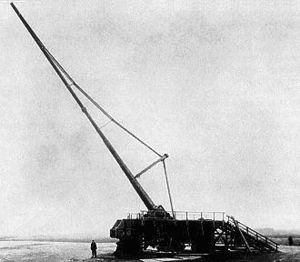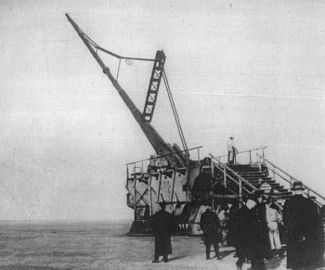Paris Gun - Picture
More about World War 1

|
|
Paris Gun

Type: Super heavy field cannon
Place of origin: German Empire
Service history:
Used by: Imperial Germany
Wars: World War I
Production history:
Designer: Krupp
Manufacturer: Krupp
Specifications:
Weight: 256 tons
Length: 28 m (91 ft 10 in)
:
Caliber: 211 mm, later 238 mm
Elevation: 55 degrees
Muzzle velocity: 1,600 m/s (5,200 ft/s)
Effective range: 130 km (81 mi)
The Paris Gun (German: Paris-Geschx¼tz) was a German long-range siege gun used to bombard Paris during World War I. It was in service from March-August 1918. When it was first employed, Parisians believed they'd been bombed by a new type of high-altitude zeppelin, as neither the sound of an airplane nor a gun could be heard. It was the largest piece of artillery used during the war by barrel length if not caliber, and is considered to be a supergun.
Also called the "Kaiser Wilhelm Geschx¼tz" ("Emperor William Gun"), it is often confused with Big Bertha, the German howitzer used against the Lix¨ge forts in 1914; indeed, the French called it by this name, as well. It's also confused with the smaller "Langer Max" (Long Max) cannon, from which it was derived; although the famous Krupp-family artillery makers produced all these guns, the resemblance ended there.
As a military weapon, the Paris Gun was not a great success: the payload was minuscule, the barrel required frequent replacement and its accuracy was only good enough for city-sized targets. However, the German objective was to build a psychological weapon to attack the morale of the Parisians, not to destroy the city itself.
Description
![World War 1 Picture - German gun crew preparing the Paris Gun[dubious - discuss]](./images/1-images52211/325px-ParisGunShellPreparation1918.jpeg)
Picture - German gun crew preparing the Paris Gun[dubious - discuss]
The Paris Gun was a weapon like no other, but its capabilities are not known with certainty. This is due to the weapon's apparent total destruction by the Germans in the face of the Allied offensive. Figures stated for the weapon's size, range, and performance vary widely depending on the source - not even the number of shells fired is certain.
The gun was capable of hurling a 94 kilogram (210 lb) shell to a range of 130 kilometers (81 miles) and a maximum altitude of 40 kilometers (25 miles, 131,000 ft) - the greatest height reached by a human-made projectile until the first successful V-2 flight test in October 1942. At the start of its 170-second trajectory, each shell from the Paris Gun reached a speed of 1,600 meters per second (5,250 ft/s).
Seven barrels were constructed. They used worn-out 38 cm SK L/45 "Max" gun barrels that were fitted with an internal tube that reduced the caliber from 380 millimetres (15 in) to 210 millimetres (8 in). The tube was 30 metres (98 ft) long and projected 12.9 metres (42 ft) out of the end of the gun, so an extension was bolted to the old gun-muzzle to cover and reinforce the lining tube. A further, smooth-bore extension was attached to the end of this, giving a total barrel length of 36 metres (118 ft). This smooth section was intended to improve accuracy and reduce the dispersion of the shells, as it reduced the slight yaw a shell might have immediately after leaving the gun barrel, that is produced by the gun's Rifling. The barrel was braced to counteract barrel droop due to its length and weight, and vibrations while firing; it was mounted on a special rail-transportable carriage and fired from a prepared, concrete emplacement with a turntable. The original breech of the old, 38cm gun did not require modification or reinforcement.
Since it was based on a naval weapon, the gun was manned by a crew of 80 Imperial Navy sailors under the command of an admiral. It was surrounded by several batteries of standard army artillery to create a "noise-screen" chorus around the big gun so that it could not be located by French and British spotters.
The projectile reached so high that it was the first human-made object to reach the stratosphere. This virtually eliminated drag from air resistance, allowing the shell to achieve a range of over 130 kilometres (81 mi). The Paris Gun was the largest gun built at the time, but it was surpassed in all respects but range in World War II by the Schwerer Gustav. The unfinished V-3 cannon and Iraqi super gun would have been bigger.
Projectiles
![World War 1 Picture - Post-war diagram of a Paris gun shell,[3]](./images/1-images52211/250px-Miller_Paris_Gun_Shell_diagrams.jpg)
Picture - Post-war diagram of a Paris gun shell,[3]
The Paris Gun shells were propelled at such a high velocity that each successive shot wore away a considerable amount of steel from the rifled bore. Each shell was sequentially numbered according to its increasing diameter, and had to be fired in numeric order, lest the projectile lodge in the bore, and the gun explode. Also, when the shell was rammed into the gun, the chamber was precisely measured to determine the difference in its length: a few inches off would cause a great variance in the velocity, and with it, the range. Then, with the variance determined, the additional quantity of propellant was calculated, and its measure taken from a special car and added to the regular charge. After 65 rounds had been fired, each of progressively larger caliber to allow for wear, the barrel was sent back to Krupp and rebored to a caliber of 238 mm (9.4 in) with a new set of shells.
The body of the shell was composed of massively thick steel, containing around 15 kg (33 lb) of explosiveThe small amount of explosive - 15% of the weight of the shell - meant that the effect of its shellburst was considered small for the shell's size. The abnormal thickness of the shell casing, to withstand the massive forces of firing, meant that shell would explode into a comparatively small number of large fragments, limiting its destructive effect. A crater produced by a shell falling in the Tuileries Garden was described by an eye-witness as being 10 to 12 ft (3.0 to 3.7 m) across and 4 ft (1.2 m) deep.
The explosive was contained in two compartments, separated by a wall. This strengthened the shell and supported the explosive charge under the acceleration of firing. One of the shell's two fuses was mounted in the wall, with the other in the base of the shell. The shell's nose was fitted with a streamlined, lightweight, ballistic cap - a highly unusual feature for the time - and the side had grooves that engaged with the rifling of the gun barrel, spinning the shell as it was fired so its flight was stable. Two copper driving bands provided a gas-tight seal against the gun barrel during firing.
Use in World War I

Picture - Paris gun
The gun was fired from the forest of Coucy and the first shell landed at 7:18 a.m. on March 23, 1918 on the Quai du Seine, the explosion being heard across the city. Shells continued to land at 15 minute intervals, with 21 counted on the first day. The initial assumption was these were bombs dropped from aircraft too high to be seen. But within a few hours, sufficient casing fragments had been collected to show that the explosions were the result of shells, not bombs. By the end of the day, military authorities were aware the shells were being fired from behind German lines by a new, long range gun, although there was initial, wild press speculation on the origin of the shells. This included the theory they were being fired by German agents close-by Paris, or even within the city itself so abandoned quarries close to the city were searched for a hidden gun. However, within days, the gun had been found by the French air reconnassance; it was located by French aviator Didier Daurat.
The Paris gun emplacement was dug out of the north side of the wooded hill at Chateau Bellevue near Crépy, Aisne. The gun was mounted on heavy steel rails embedded in concrete, facing Paris. The chateau is located on the south side of the same hill. First built as a French monastery and later converted to a chateau by a Dutch baron, Chateau Bellevue was taken over and used by the Germans as a headquarters for the Paris gun. During World War I, the baron and his family were allowed to stay in the chateau with the Germans. The Germans added a tennis court, bowling alley, and swimming pool. Barracks and tunnels were dug underground, with vertical ventilation holes to the field atop the hill.
The Paris gun was used to shell Paris at a range of 120 km (75 miles). The distance was so far that the Coriolis effect - the rotation of the Earth - was substantial enough to affect trajectory calculations. The gun was fired at an azimuth of 232 degrees (west-southwest) from Crépy-en Laon, which was at a latitude of 49.5 degrees North. The gunners had to account for the fact that the projectiles landed to the right of where they would have hit if there were no Coriolis effect.
In total, about 320 to 367 shells were fired, at a maximum rate of around 20 per day. The shells killed 250 people and wounded 620, and caused considerable damage to property. The worst incident was on 29 March 1918, when a single shell hit the roof of the St-Gervais-et-St-Protais Church, collapsing the entire roof on to the congregation then hearing the Good Friday service. A total of 88 people were killed and 68 were wounded.
The gun was taken back to Germany in August 1918 as Allied advances threatened its security. The gun was never captured by the Allies. It is believed that near the end of the war it was completely destroyed by the Germans. One spare mounting was captured by American troops near Chx¢teau-Thierry, but the gun was never found; the construction plans seem to have been destroyed as well.
The Paris Gun holds a significant place in the history of astronautics. In the 1930s, the German Army became interested in rockets for long range artillery as a replacement for the Paris Gun-which was specifically banned under the Versailles Treaty.
In popular culture
A parody of the Paris Gun appears in the Charlie Chaplin movie The Great Dictator. Firing at the Cathedral of Notre Dame the Germans succeed in blowing up a small outhouse.
Krupp K5 ("Anzio Annie")
21 cm K 12 (E)
Bibliography
Henry W. Miller, Railway Artillery: A Report on the Characteristics, Scope of Utility, etc. of Railway Artillery, United States Government Printing Office, 1921
Henry W. Miller, The Paris Gun: The Bombardment of Paris by the German Long Range Guns and the Great German Offensive of 1918, Jonathan Cape, Harrison Smith, New York, 1930
Gerald V. Bull, Charles H. Murphy, Paris Kanonen: The Paris Guns (Wilhelmgeschutze) and Project HARP, E. S. Mittler, Herford, 1988
Ian V. Hogg, The Guns 1914 -18, Ballantine Books, New York, 1971
More aircraft.
Source: WikiPedia